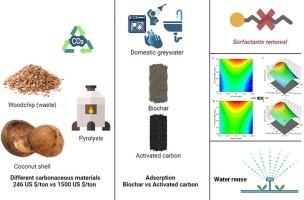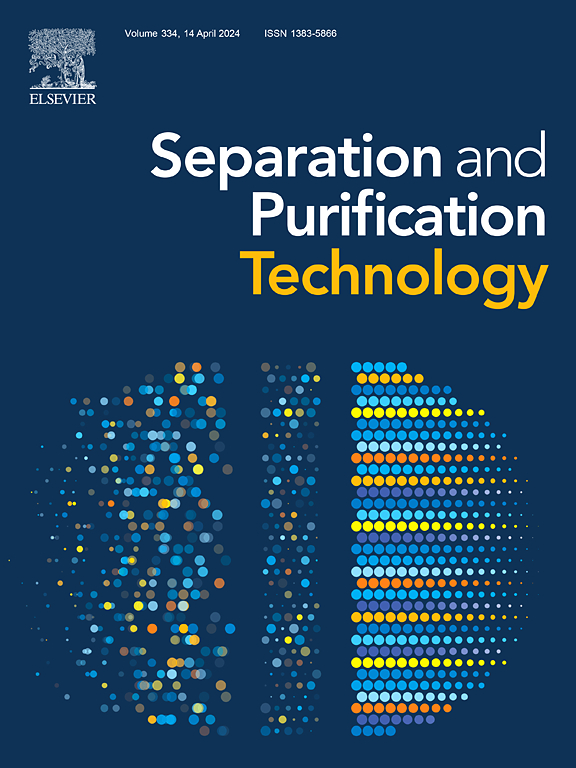使用活性炭和木屑生物炭去除表面活性剂和有机物的中水处理比较研究
IF 8.1
1区 工程技术
Q1 ENGINEERING, CHEMICAL
引用次数: 0
摘要
灰水(GW)处理因其病原体含量较低、化学需氧量(COD)和表面活性剂浓度较高,而被认为是黑水处理的更有效替代品,尤其是在回用方面。在本研究中,比较了木屑生物炭(BC)和活性炭(AC)去除 GW 中 COD、阴离子表面活性剂(ASU)和非离子表面活性剂(NISU)的吸附性能。采用响应面法(RSM)对有机物和表面活性剂的去除效率进行了优化。AC 对 COD 和 ASU 具有更高的吸附能力,对 COD 的吸附能力为 KL = 0.007 L/mg 和 Qmax = 0.95 mg/g,对 ASU 的吸附能力为 KL = 1.4 × 104 L/mg 和 Qmax = 0.08 mg/g。相比之下,BC 对 NISU 的亲和力明显更高,KL = 8.4 × 103 L/mg,Qmax = 0.01 mg/g。突破曲线和假一阶(PFO)动力学提供了对吸附动力学的深入了解,AC 显示出延迟突破和更长的吸附寿命,而 BC 则提供了快速吸附和成本效益。经过处理的 GW 可大幅降低污染物水平,最终 COD 和表面活性剂浓度分别降至约 10 毫克/升和 0.05 毫克/升,符合意大利和澳大利亚的监管标准。这项研究强调了木片 BC 作为一种具有成本效益和可持续发展的 AC 替代品的潜力,尤其是在短期吸附应用中,并为处理 GW 供再利用提供了宝贵的见解。本文章由计算机程序翻译,如有差异,请以英文原文为准。

Comparative study of greywater treatment using activated carbon and woodchip biochar for surfactant and organic matter removal
Greywater (GW) treatment is recognized as a more efficient alternative to blackwater treatment, particularly for reuse applications, due to its lower pathogen content and higher concentrations of chemical oxygen demand (COD) and surfactants. In this study, the adsorption performance of woodchip biochar (BC) and activated carbon (AC) was compared for the removal of COD, anionic surfactants (ASU), and non-ionic surfactants (NISU) from GW. Response Surface Methodology (RSM) was employed to optimize the removal efficiency of both organic matter and surfactants. AC demonstrated higher adsorption capacities for COD and ASU, with KL = 0.007 L/mg and Qmax = 0.95 mg/g for COD, and KL = 1.4 × 104 L/mg and Qmax = 0.08 mg/g for ASU. In contrast, BC showed a significantly higher affinity for NISU, with KL = 8.4 × 103 L/mg and Qmax = 0.01 mg/g. Breakthrough curves and pseudo-first-order (PFO) kinetics provided insights into adsorption dynamics, with AC showing delayed breakthrough and greater longevity, while BC offered rapid adsorption and cost-effectiveness. The treated GW achieved substantial reductions in contaminant levels, with final COD and surfactant concentrations reduced to approximately 10 mg/L and 0.05 mg/L, respectively, meeting Italian and Australian regulatory standards. The study highlights the potential of woodchip BC as a cost-effective and sustainable alternative to AC, particularly for short-term adsorption applications, and offers valuable insights into the treatment of GW for reuse.
求助全文
通过发布文献求助,成功后即可免费获取论文全文。
去求助
来源期刊

Separation and Purification Technology
工程技术-工程:化工
CiteScore
14.00
自引率
12.80%
发文量
2347
审稿时长
43 days
期刊介绍:
Separation and Purification Technology is a premier journal committed to sharing innovative methods for separation and purification in chemical and environmental engineering, encompassing both homogeneous solutions and heterogeneous mixtures. Our scope includes the separation and/or purification of liquids, vapors, and gases, as well as carbon capture and separation techniques. However, it's important to note that methods solely intended for analytical purposes are not within the scope of the journal. Additionally, disciplines such as soil science, polymer science, and metallurgy fall outside the purview of Separation and Purification Technology. Join us in advancing the field of separation and purification methods for sustainable solutions in chemical and environmental engineering.
 求助内容:
求助内容: 应助结果提醒方式:
应助结果提醒方式:


